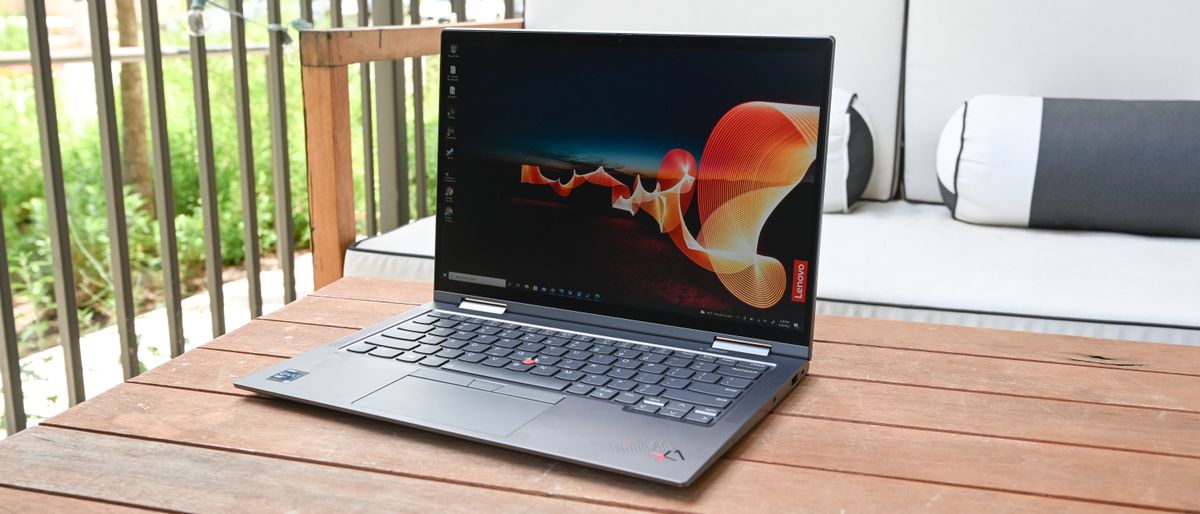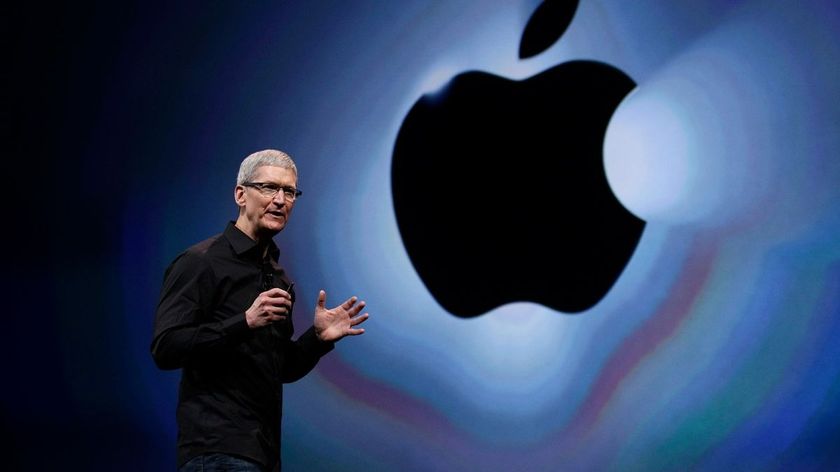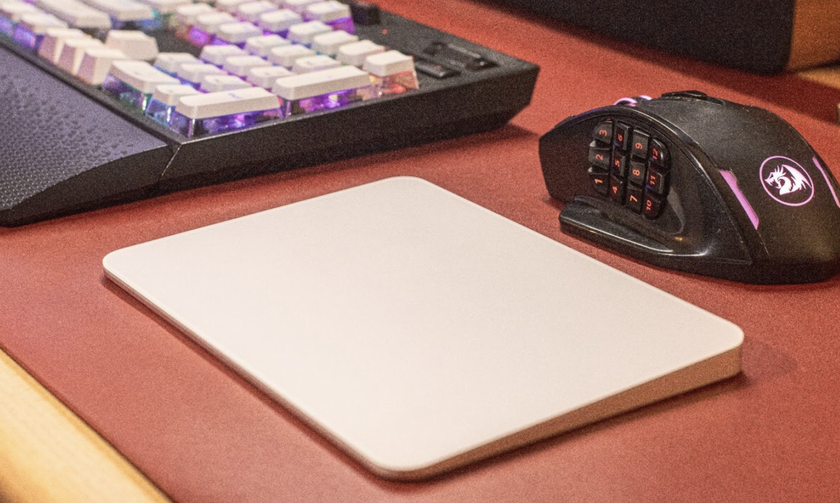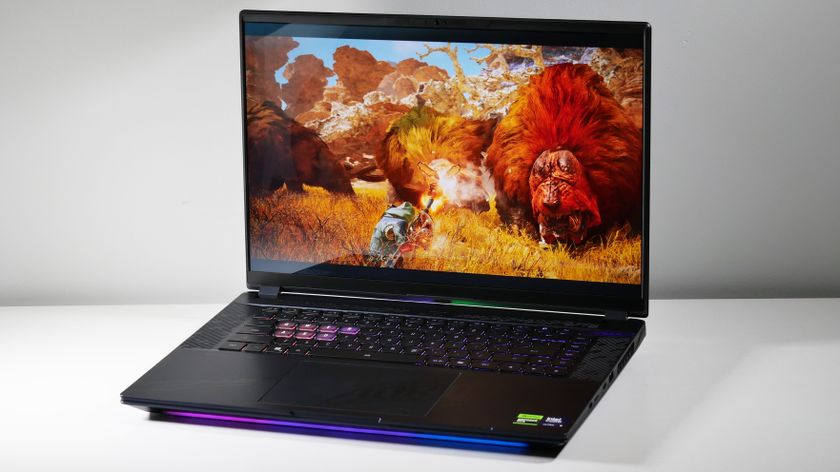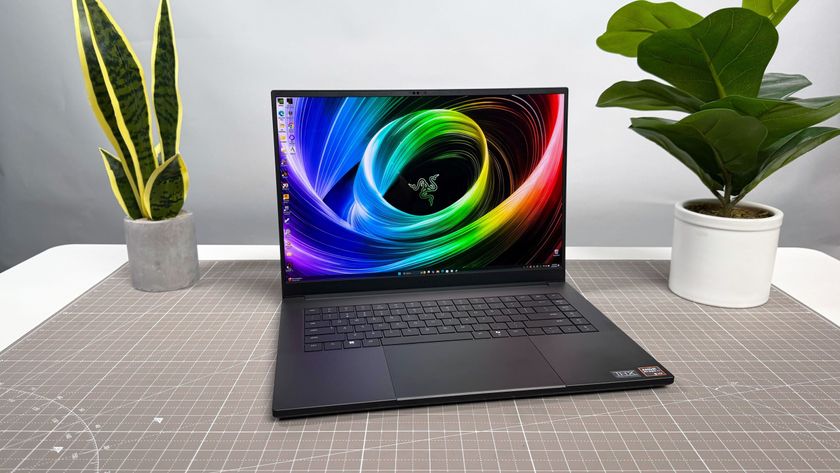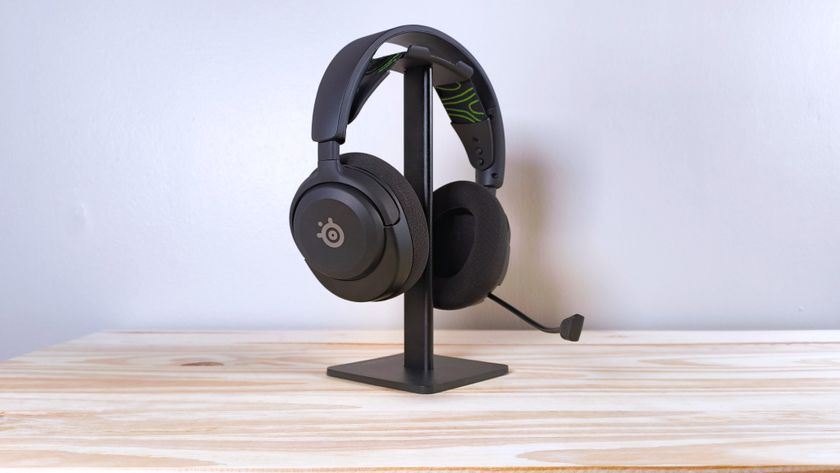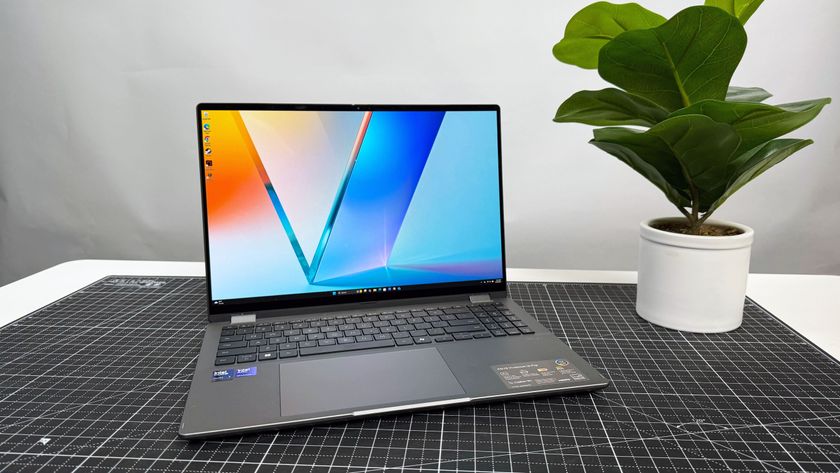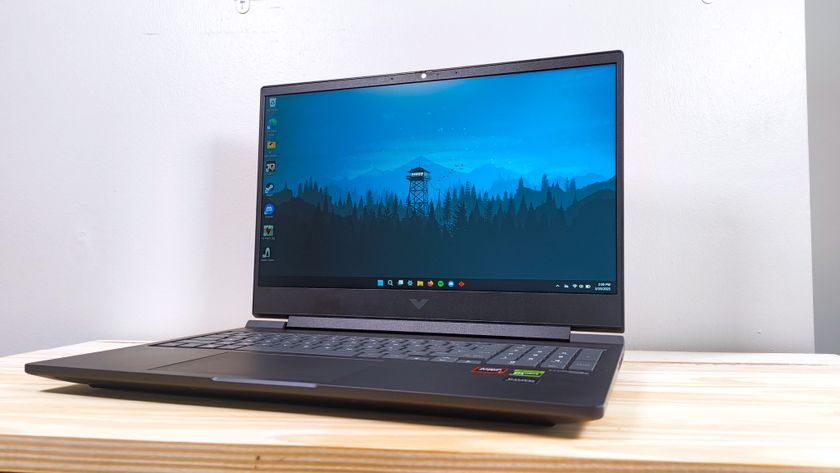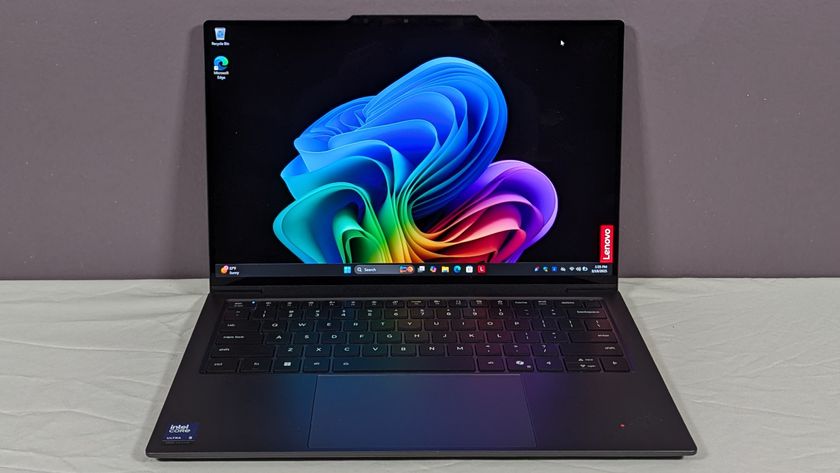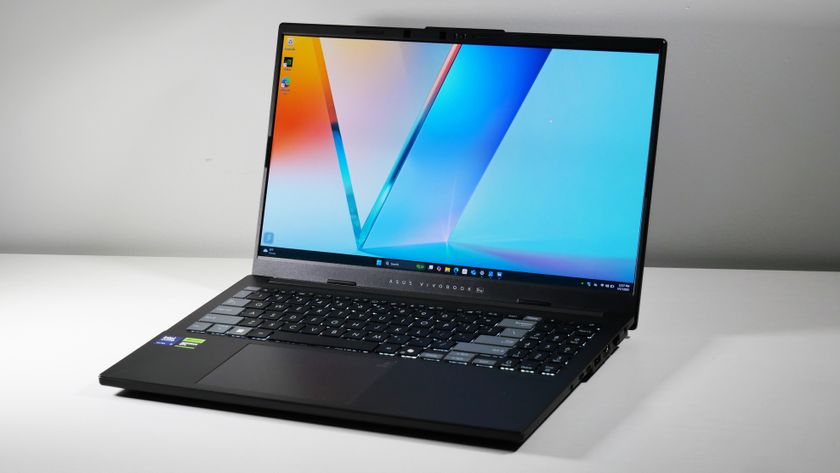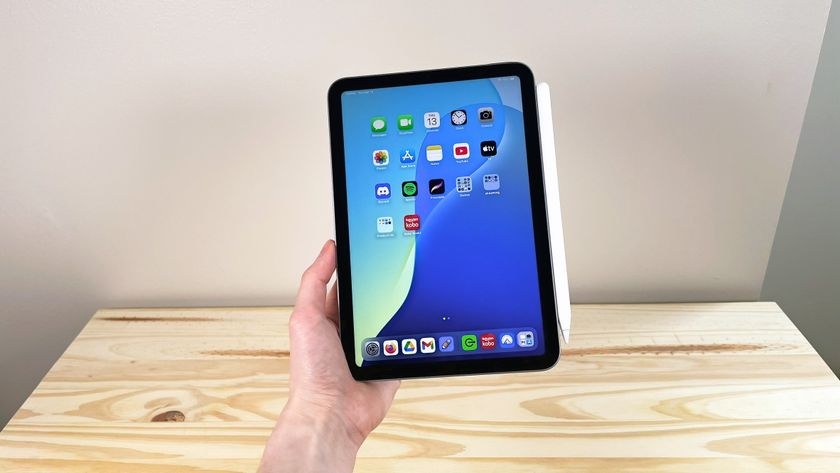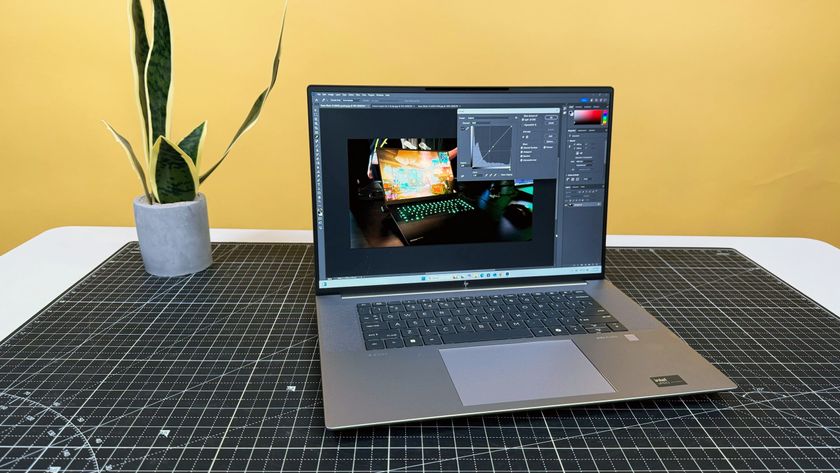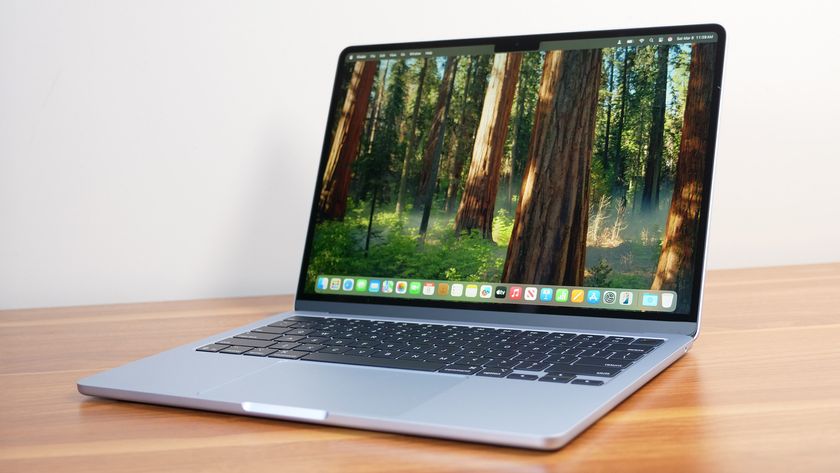Laptop Mag Verdict
Lenovo's ThinkPad X1 Yoga tweaks the formula enough to retain its position as the best 2-in-1 business laptop (a lot of) money can buy.
Pros
- +
Solid, sleek design
- +
Fantastic keyboard
- +
Speedy performance
- +
Long battery life
- +
Built-in stylus slot
Cons
- -
Heavier than some competitors
- -
No SD card slot
- -
Expensive
Why you can trust Laptop Mag
Price: $1,304 (starting); $2,339 (reviewed at)
CPU: Intel Core i7-1165G7 CPU
GPU: Iris Xe
RAM: 16GB
Storage: 512GB SSD
Display: 14-inch, 1920 x 1200-pixel IPS (16:10)
Battery: 14:45
Size: 12.3 x 8.8 x 0.6 inches
Weight: 3 pounds
Lenovo's ThinkPad X1 Yoga Gen 6 is a refinement of the best 2-in-1 laptop for business users. Taking a page from the X1 Carbon, the newest Yoga now flaunts a 14-inch display with a taller 16:10 aspect ratio for more vertical screen space — a boon for enterprise users. Also improving productivity are a wider touchpad and a human presence detection sensor for convenient login and enhanced security.
Swapping the engine for 11th Gen Intel chips adds considerably faster performance, but the battery life upgrade is even more enticing; the Gen 6 model lasts for nearly 15 hours on a charge. These perks are packaged in a sleek aluminum chassis with a convenient 2-in-1 design and a handy stylus slot. It may not be as lightweight as the ThinkPad X1 Carbon or as alluring as the ThinkPad X1 Titanium Yoga, but the ThinkPad X1 Yoga Gen 6 could just be the best overall package of the trio.
Lenovo ThinkPad X1 Yoga price and configurations
I wouldn't buy the X1 Yoga from Lenovo at the time of writing. When I used the Lenovo.com configuration tool to create our review unit, it came out to be $3,345 for a model with an FHD+ display, an Intel Core i7-1165G7 CPU, 16GB of RAM and a 512GB SSD. That same version costs $2,339 at B&H Photo Video and $2,579 at Walmart.
For comparison, the Gen 5 model we reviewed last year cost $2,106 and was equipped with a Core i7-10610U CPU, 16GB of RAM, a 512GB SSD and a 14-inch, 4K panel.
If you want to save some money — and I wouldn't blame you for doing so — the base configuration costs $1,304 and comes with an FHD+ display, an Intel Core i5-1135G7 CPU, 8GB of RAM and a 256GB SSD. For $305 more, you can get 16GB of RAM and a 512GB SSD.
If you aren't on a budget, for $3,979 you can get the 4K (UHD+) version with a Core i7-1185G7 CPU, 16GB of RAM and a 1TB SSD. It should be said that at that price, you can buy almost any non-workstation laptop on the market.
Lenovo ThinkPad X1 Yoga design
Subtle design changes give the X1 Yoga Gen 6 an edge over its predecessor.
The most obvious (and my favorite) was replacing the black keyboard with one that matches the chassis' Storm Gray hue. It gives the laptop a more cohesive aesthetic — one that adds to the sleekness of the design. Among Lenovo's efforts to make the X1 Carbon appeal to consumers is a larger, bolder ThinkPad X1 logo on the deck and lid. Brash branding isn't always welcome, but in this case, it adds some flair to an otherwise ordinary design.
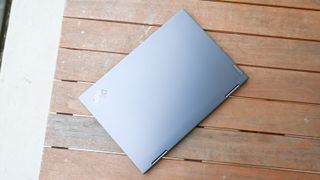
The X1 Yoga retains the aluminum chassis introduced a few years ago as a replacement to the black carbon fiber still found on the X1 Carbon. The cool metal feels premium and robust, but I prefer the traditional ThinkPad magnesium/carbon material; aluminum is heavier and doesn't have the same soft-touch finish.
Moved from the side to the deck is an oblong power button with a small LED indicator and a built-in fingerprint scanner. The new placement allows for easier access and reduced likelihood of accidentally waking the Yoga in a bag or briefcase. On the other hand, having the power button on the side means you could easily wake and shut down the X1 Yoga with the lid closed when connected or docked to a monitor.
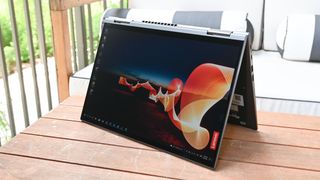
Replacing the single speaker bar on the previous model are separate speaker grilles flanking each side of the deck. The palm rest no longer houses a discrete fingerprint scanner as the biometric sensor was moved to the new power button. One returning convenience is the stylus garage on the right edge of the laptop which is used for storing and charging the pen. The Laptop Mag staff highlighted this feature as a way for vendors to improve 2-in-1 laptops — why we haven't seen widespread adoption baffles me to this day.
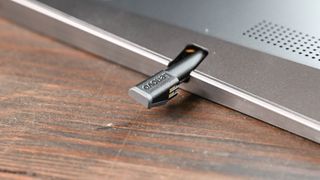
The dual hinges feel stiff, but rotate back smoothly when converting this 2-in-1 laptop into tent or tablet mode. Being a convertible (with an aluminum chassis) adds some heft compared to clamshell laptops; the X1 Yoga comes in at 12.3 x 8.8 x 0.6 inches and 3 pounds, making it heavier than the ThinkPad X1 Carbon (12.7 x 8.5 x 0.6 inches, 2.4 pounds), the X1 Titanium (11.7 x 9.2 x 0.45 inches, 2.5 pounds), the Dell Latitude 9420 2-in-1 (12.2 x 8.5 x 0.5 inches, 2.8 pounds )and the HP EliteBook 1040 G7 (12.6 x 8 x 0.7 inches, 2.9 pounds).
Lenovo ThinkPad X1 Yoga security and durability
The X1 Yoga checks all the security and durability boxes. Biometric login methods include a fingerprint scanner embedded in the power button and an optional IR camera for facial recognition via Windows Hello. Enhancing the feature is a human detection sensor that wakes your screen when within close proximity of the laptop. Our unit wasn't equipped with the IR camera so we couldn't test the feature on the X1 Yoga, but it worked well on the previous model.
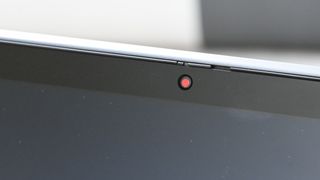
Also providing hardware-based security is TPM 2.0, a chip that has received much attention lately for being a requirement to run Windows 11.
The X1 Yoga is as durable as it is secure. It passed a dozen MIL-STD-810G tests, meaning it can withstand extreme conditions like high humidity, sand and dust exposure, and mechanical shock.
Lenovo ThinkPad X1 Yoga ports
Continuing the trend, this latest X1 Yoga version introduces a few changes to the ports.
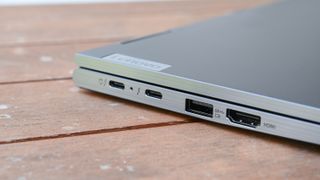
On the left edge are two Thunderbolt 4 ports, a USB 3.2 Type-A input and an HDMI 2.0 connection. Absent is the proprietary network extension connector seen in the previous models.
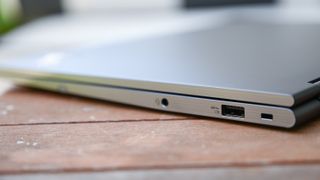
Along the right side, you’ll find a second USB 3.2 Type-A, a headphone jack and a lock slot. It's a generous assortment of I/O; my only gripe is that the USB-C ports are on the same side, so you can only charge from the left side.
Lenovo ThinkPad X1 Yoga display
Tearing a page from the ThinkPad X1 Carbon, the X1 Yoga Gen 6 debuts a new 14-inch, 1920 x 1200-pixel IPS display with a 16:10 aspect ratio. We tested the FHD+ screen, but those who need the absolute best picture quality should consider the brighter and more detailed 4K panel.
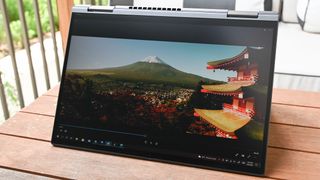
If you prioritize battery life, go with the standard display — you’ll get a good viewing experience to go along with several additional hours of runtime. I enjoyed watching the Germany vs. England Euro 2020 quarterfinals match as much as it pained me to see my country lose. The panel was sharp enough for me to track the ball and the colorful boots worn by the outfield players stood out against the black-and-white jerseys. Best of all, the matte screen dampened light sources, so I wasn't forced to look past my own reflection.
Watching the trailer for Snake Eyes on the ThinkPad X1 Yoga was a two-minute thrill ride. The display kept pace with the frenetic fighting scene at the start of the clip, and then dazzled as the scenes changed from an underground fighting ring to the splendor of Mount Fuji. Neon signs illuminating a rainy rooftop at night burst with more vivid colors than I anticipated on a matte panel. The screen is also well-calibrated out of the box as skin tones looked natural and web page backgrounds were snow white.
This is a case where the eye test doesn't match our colorimeter readings. We determined the screen is capable of covering 71% of the DCI-P3 color gamut — a good result, but lower than I expected. It is less vibrant than the panel on the EliteBook x360 1040 (76%), Latitude 9410 2-in-1 (89%) and the X1 Carbon (72%). The average panel on a premium laptop (84%) is more colorful.
Brightness levels on the X1 Yoga are good, climbing to a peak of 351 nits. That is right around the EliteBook x360 1040 (344 nits) and the X1 Carbon (364 nits), but dimmer than the Latitude 9420 2-in-1 (477 nits) and premium laptop average (389 nits).
Lenovo ThinkPad X1 Yoga keyboard, touchpad and pointing stick
What more is there to say that hasn't already been written in love letters to Lenovo's fantastic ThinkPad keyboards? This one is as good as the next. Tactile keys reward your fingers with a snappy "thump" before springing them from one letter to the next. Key travel is excellent for a laptop this thin, and the size and spacing of the keys should accommodate all hand sizes.
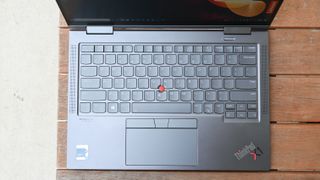
There are a few undersized keys (right Alt, PrtSc), but not ones most people use regularly. Also useful are the inverted-T arrow key orientation and the updated shortcut keys for answering/ending or muting/unmuting a conference call. Remember, the webcam cover lets you quickly turn off your video feed to avoid embarrassment when your cat jumps onto your shoulders.
Alas, perfection evades us again as Lenovo insists on swapping the left Fn and Ctrl keys. As a result, touch typists can't instinctively reach for the bottom-left-most key when performing Windows shortcuts like Ctrl+C to copy. I've gotten used to the layout having used the ThinkPad TrackPoint Keyboard II for the better part of a year, but it trips me up every time I use, well, any other keyboard. Fortunately, you can switch these keys in the Lenovo Vantage app.
I typed at a speedy 111 words per minute with a 94% accuracy on the 10FastFingers.com typing test, outpacing my usual 109-wpm at 95% average.
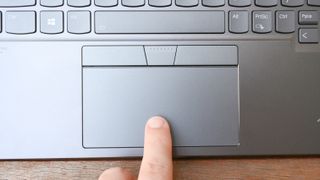
The 4.3 x 2.2-inch touchpad is sufficiently wide, but rather squat; my fingers brushed the top and bottom edges when I executed Windows 10 gestures like pinch-to-zoom and two-finger scrolling. Fortunately, the glass surface is silky and responsive.

As always, the red rubber pointing stick is nestled in the center of the keyboard and accompanied by left, center and right clickers above the touchpad. Interestingly, the buttons lack the red accents Lenovo adds to all other models.
Lenovo ThinkPad X1 Yoga stylus
Housed in a slot on the right edge of the X1 Yoga is an included stylus for drawing, taking notes, or browsing the web without smudging up the touchscreen. The stylus isn't the most comfortable to use, but the convenience of having it always on-hand outweighs the limitation caused by its small size. I sketched a picture of a flower in Paint 3D and the pen kept up with my movements, allowing me to make smooth, accurate lines.
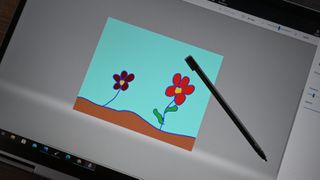
If you're an artist who needs the best equipment for work, the Active Pen 2 ($66) and Pen Pro ($99) are both compatible with the X1 Yoga.
Lenovo ThinkPad X1 Yoga audio
Quad speakers combined with Dolby Atmos software give the ThinkPad X1 Yoga sonic oomph. When I listened to slenderbodies & Tim Atlas' "Focus," the hushed vocals sounded crisp and the various synth sounds were nicely separated. Glass Animals' "Life Itself," made me do a little dance as the X1 Yoga's speakers kept up with the fast tempo and complex track layering.
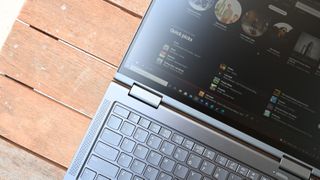
Increasing to max volume strained the treble, causing some clarity loss. While there was never any distortion, I wouldn't listen to them at above 90% unless you're using the laptop to fill a large room. Even then, a Bluetooth speaker will give you a better listening experience with more bass than the tame low-end produced by the X1 Yoga.
Lenovo ThinkPad X1 Yoga performance
Powering our X1 Yoga is an Intel Core i7-1165G7 CPU with 16GB of RAM, a combo powerful enough to run demanding workloads. I put the X1 Yoga to the test by loading 30 Google Chrome tabs, four of which played 1080p YouTube videos simultaneously while a pair of Twitch streams lingered in the background. Videos played instantly and graphics flashed onto the page. I didn't notice any significant stuttering even when I streamed a Euro 2020 soccer match though websites took just a split second longer to fully load.
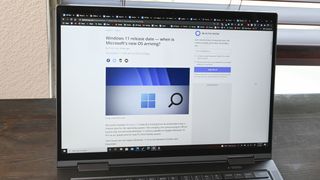
On the Geekbench 5.4 overall performance test, the ThinkPad X1 Yoga scored a 5,447, putting it in second behind the Latitude 9420 2-in-1 (6,037) but ahead of its older rivals: the ThinkPad X1 Carbon (3,935) and EliteBook x360 1040 G7 (4,692). The category average sits at 4,376.
The X1 extended its strong start on the video transcoding test by converting a 4K video to 1080p in 13 minutes and 50 seconds. It outpaced its sibling, the X1 Carbon (19:51), and the EliteBook x360 1040 (16:25), but crossed the finish line just behind the Latitude 9420 2-in-1 (13:35).
Annoyed with winning the consolation prize, the X1 Yoga topped the Latitude 9310 2-in-1 in our storage speed test; the Lenovo's 512GB PCIe NVMe SSD duplicated 25GB of multimedia files at a rate of 531.3 megabytes per second. Lagging behind was the Latitude (401.9 MBps), EliteBook x360 1040 G7 (439.2 MBps) and X1 Carbon (462.9 MBps). Still, the Yoga couldn't outpace the average (621.43 MBps).
Lenovo ThinkPad X1 Yoga graphics
The X1 Yoga is no gaming laptop, but its integrated Intel Iris Xe graphics chip is capable of running most enterprise tasks without issue.
On the synthetic 3DMark Fire Strike test, the ThinkPad X1 Yoga scored a 4,780, ahead of the EliteBook x360 1040 G7 (1,229, UHD) and X1 Carbon (1,219, UHD) but behind the average (4,830) and the Latitude 9210 2-in-1 (5,258, Iris Xe).
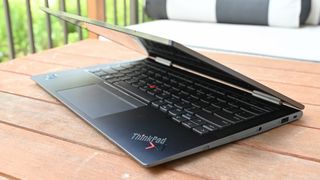
You can play some lightweight games as shown in the Sid Meier's Civilization VI: Gathering Storm benchmark, which played at a smooth 34 frames per second on the X1 Yoga. The X1 Yoga was the only laptop among its peers to top our 30-fps threshold; the Latitude 9410 2-in-1 (23 fps), ThinkPad X1 Carbon (8 fps) and the average premium laptop (28 fps) fell short.
If you don't want to purchase a gaming laptop with a discrete graphics card, consider buying an eGPU to run the latest games on the X1 Yoga.
Lenovo ThinkPad X1 Yoga battery life
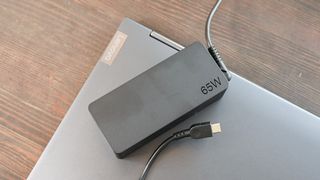
The X1 Yoga has always delivered a full day of battery life, but the 6th Gen model is the first to stay powered deep into a second day of use. Enduring for 14 hours and 45 minutes on the Laptop Mag Battery Test, the X1 Yoga outclassed the ThinkPad X1 Carbon (10:45) and the category average (10:36) but ran out of steam just before the EliteBook x360 1040 G7 (15:45) and Latitude 9420 (15:02).
Lenovo ThinkPad X1 Yoga webcam
Lenovo only partly addressed the pains of working remotely by using four far-field microphones with Dolby Voice for clear voice quality during video calls. What it failed to address was the elephant in every virtual meeting room: poor webcam quality.

Even with direct light shining overhead, the 720p camera failed to capture facial details in a selfie I snapped. My beard was a singular blob, my eyes looked like dark voids and my skin was so blotchy that (perhaps mercifully) you couldn't see any imperfections. Laptop brands know the importance of webcams in the era of remote working, and yet, we're not seeing much movement to improve their quality. If there is a silver lining, an abundance of excellent external webcams flooded the market since the beginning of the ongoing pandemic.
Lenovo ThinkPad X1 Yoga heat
The X1 Yoga did a commendable job of keeping its cool in our heat test, which consists of playing a 15-minute 1080p video before getting temperature checks in various areas of the chassis.
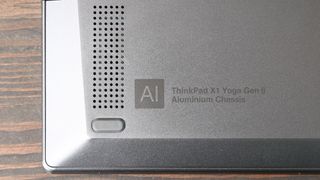
Starting with the good news, the places where your skin touches, like the touchpad (81 degrees) and keyboard (86 degrees), remained reassuringly below our 95-degree Fahrenheit comfort threshold. Less comforting is that the bottom panel reached 101 degrees; that's warm, but nothing to be too concerned about.
Lenovo ThinkPad X1 Yoga software and warranty
Commercial Vantage is one pre-installed app you won't want to delete. This is your go-to program for system maintenance, including downloading the latest updates, changing power settings or monitoring battery health. The app also shows warranty status and basic system specs.
Also installed on the X1 Yoga is a Dolby app for adjusting the mic and speakers as well as another Lenovo-branded app for customizing the stylus settings. Third-party apps are graciously absent apart from your standard Windows 10 suite.
The X1 Yoga Gen 6 comes with a one-year warranty. See how Lenovo fared on our Tech support showdown and Best and worst brands special reports.
Bottom line
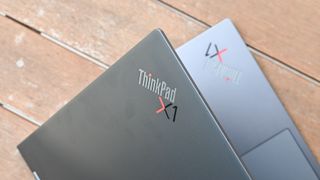
It's easy to overlook the ThinkPad X1 Yoga. Ignore competing brands and the hybrid laptop still has to make a case against the ThinkPad X1 Carbon, X1 Titanium Yoga, X1 Nano and X1 Extreme — a group of critically acclaimed business laptops, each with their strengths. But after putting the X1 Yoga Gen 6 through its paces, I strongly advise giving this laptop your full attention.
If you need a portable 2-in-1 laptop — for business or otherwise — and aren't on a tight budget, the X1 Yoga Gen 6 is one to consider. There simply aren't many weaknesses to this convertible. The 11th Gen Intel CPUs provide fast performance and epic endurance, while the sleek chassis is slim enough to take on a business trip or to the cafe when you're working remotely. The X1 Yoga separates itself from others in the field with a bounty of extra features, from the IR camera and fingerprint sensor to the garaged stylus and webcam cover. It isn't perfect; an SD card slot would have roped in content creators, and the lofty price excludes anyone hoping to spend less than $1,500.
If you're a business user who wants a portable 2-in-1 laptop, or an IT admin setting your team up with the very best hardware, then the ThinkPad X1 Yoga is a first-rate choice. I'd be remiss to not mention other capable options in the segment — like the HP EliteBook 1040 G7 or the Dell Latitude 9420 2-in-1 — so shop wisely before settling on such a hefty investment.
Phillip Tracy is the assistant managing editor at Laptop Mag where he reviews laptops, phones and other gadgets while covering the latest industry news. After graduating with a journalism degree from the University of Texas at Austin, Phillip became a tech reporter at the Daily Dot. There, he wrote reviews for a range of gadgets and covered everything from social media trends to cybersecurity. Prior to that, he wrote for RCR Wireless News covering 5G and IoT. When he's not tinkering with devices, you can find Phillip playing video games, reading, traveling or watching soccer.
